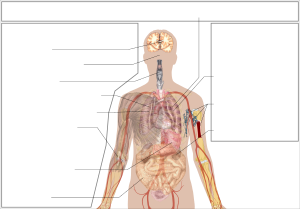Wikipedia:WikiProject COVID-19/Translation Task Force/Coronavirus disease 2019 (short)

Coronavirus disease 2019 (COVID-19) is an infectious disease caused by severe acute respiratory syndrome coronavirus 2 (SARS-CoV-2).[1] The disease was first identified in 2019 in Wuhan, Central China, and has since spread globally, resulting in a pandemic and affecting over 100 countries of the world.[2][3] Common symptoms include fever, cough, and shortness of breath. Muscle pain, sputum production and sore throat are less common.[4] While the majority of cases result in mild symptoms,[5] some progress to severe pneumonia and multi-organ failure.[2][6] Around 0.2% to 15% of those affected with coronavirus disease die.[7]
The virus is typically transmitted from one person to another via respiratory droplets produced during coughing.[8] It may also be spread from touching contaminated surfaces and then touching one's face.[8] Time from exposure to onset of symptoms is generally between two and 14 days, with an average of five days.[9][10] The standard method of diagnosis is by reverse transcription polymerase chain reaction (rRT-PCR) test from a swab taken from the nose or throat. The infection can also be diagnosed from a combination of symptoms, risk factors and a chest CT scan showing features of pneumonia.[11]
Recommended measures to prevent infection include frequent hand washing, maintaining distance from others, and keeping hands away from the face.[12] The use of masks is recommended only for those who suspect they have the virus and their caregivers, but not the general public.[13][14] There is no vaccine or specific antiviral treatment for this disease although research is ongoing. Management involves treatment of symptoms, supportive care, isolation, and experimental measures.[15]
The World Health Organization declared the 2019–20 coronavirus outbreak a pandemic[3] and a Public Health Emergency of International Concern.[16][17] Evidence of local transmission has been confirmed in many countries in the world.[18]
References edit
- ^ "Naming the coronavirus disease (COVID-19) and the virus that causes it". World Health Organization (WHO). Archived from the original on 28 February 2020. Retrieved 28 February 2020.
- ^ a b Hui DS, I Azhar E, Madani TA, Ntoumi F, Kock R, Dar O, et al. (February 2020). "The continuing 2019-nCoV epidemic threat of novel coronaviruses to global health – The latest 2019 novel coronavirus outbreak in Wuhan, China". Int J Infect Dis. 91: 264–66. doi:10.1016/j.ijid.2020.01.009. PMC 7128332. PMID 31953166.
- ^ a b "WHO Director-General's opening remarks at the media briefing on COVID-19". World Health Organization (WHO) (Press release). 11 March 2020. Retrieved 12 March 2020.
- ^ "Q&A on coronaviruses (COVID-19)". World Health Organization (WHO). Retrieved 11 March 2020.
- ^ Wang V (5 March 2020). "Most Coronavirus Cases Are Mild. That's Good and Bad News". The New York Times.
- ^ "Q&A on coronaviruses". World Health Organization (WHO). Archived from the original on 20 January 2020. Retrieved 27 January 2020.
- ^ "Wuhan Coronavirus Death Rate". www.worldometers.info. Archived from the original on 31 January 2020. Retrieved 2 February 2020.
- ^ a b "Q&A on coronaviruses". World Health Organization (WHO). 11 February 2020. Archived from the original on 20 January 2020. Retrieved 24 February 2020.
- ^ "Symptoms of Novel Coronavirus (2019-nCoV)". www.cdc.gov. 10 February 2020. Archived from the original on 30 January 2020. Retrieved 11 February 2020.
- ^ Velavan TP, Meyer CG (March 2020). "The COVID-19 epidemic". Tropical Medicine & International Health. 25 (3): 278–80. doi:10.1111/tmi.13383. PMC 7169770. PMID 32052514.
- ^ "CT provides best diagnosis for COVID-19". ScienceDaily. 26 February 2020. Retrieved 2 March 2020.
- ^ "Advice for public". World Health Organization (WHO). Archived from the original on 26 January 2020. Retrieved 25 February 2020.
- ^ CDC (11 February 2020). "2019 Novel Coronavirus (2019-nCoV)". Centers for Disease Control and Prevention. Archived from the original on 14 February 2020. Retrieved 15 February 2020.
- ^ "Advice for public". World Health Organization (WHO). Archived from the original on 26 January 2020. Retrieved 15 February 2020.
- ^ "Coronavirus Disease 2019 (COVID-19)". Centers for Disease Control and Prevention (CDC). 15 February 2020. Archived from the original on 26 February 2020. Retrieved 20 February 2020.
- ^ "Statement on the second meeting of the International Health Regulations (2005) Emergency Committee regarding the outbreak of novel coronavirus (2019-nCoV)". World Health Organization (WHO). Archived from the original on 31 January 2020. Retrieved 11 February 2020.
- ^ Mahtani S, Berger M, O'Grady S, Iati M (6 February 2020). "Hundreds of evacuees to be held on bases in California; Hong Kong and Taiwan restrict travel from mainland China". The Washington Post. Archived from the original on 7 February 2020. Retrieved 11 February 2020.
- ^ World Health Organization (March 2020). "Coronavirus disease 2019 (COVID-19): situation report, 47" (Document). World Health Organization (WHO). hdl:10665/331444.